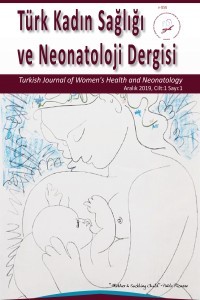Yardımcı üreme teknolojileri tedavisi uygulanacak hastalarda uterin kavitenin ve fallop tüplerinin tek adımda değerlendirilmesi: Histeroskopi ile birlikte histerosalpingo-köpük sonografi (hyfosy)
Histeroskopi, İnfertilite, Histerosalpingo-köpük Sonografi, Histerokontrast sonografi
Evaluation of the uterine cavity and fallopian tubes in one step in patients undergoing assisted reproductive technology treatment: Hysterosalpingofoam sonography (hyfosy) in combination with hysteroscopy
___
- Zeyneloglu, H.B., A. Arici, and D.L. Olive, Adverse effects of hydrosalpinx on pregnancy rates after in vitro fertilization-embryo transfer. Fertil Steril 1998; 70:492-499.
- Bosteels J, van Wessel S, Weyers S, et al., Hysteroscopy for treating subfertility associated with suspected major uterine cavity abnormalities. Cochrane Database Syst Rev 2018; 12:CD009461.
- Handelzalts JE, Levy S, Peled Y, et al., Information seeking and perceptions of anxiety and pain among women undergoing hysterosalpingography. Eur J Obstet Gynecol Reprod Biol 2016; 202:41-44.
- Suzuki, T, Shibahara H, Hirano Y, et al., Feasibility and clinical significance of endoluminal assessment by transvaginal salpingoscopy during transvaginal hydrolaparoscopy in infertile women. J Minim Invasive Gynecol 2005; 12:420-425.
- Volpi E, De Grandis T, Zuccaro G, Patriarca A, Sismondi P. A new technique to test tubal patency under transvaginal sonographic control. Acta Obstet Gynecol Scand 1994; 73:797-801.
- Maheux-Lacroix S, Boutin A, Moore L, et al., Hysterosalpingosonography for diagnosing tubal occlusion in subfertile women: a systematic review with meta-analysis. Hum Reprod 2014; 29:953-963.
- Emanuel MH and N Exalto. Hysterosalpingo-foam sonography (HyFoSy): a new technique to visualize tubal patency. Ultrasound Obstet Gynecol 2011; 37:498-499.
- Piccioni MG, Riganelli L, Filippi V, et al. Sonohysterosalpingography: Comparison of foam and saline solution. J Clin Ultrasound 2017; 45:67-71.
- Van Schoubroeck D, Van den Bosch T, Ameye L, Boes AS, D'Hooghe T, Timmerman D. Pain during Fallopian-tube patency testing by hysterosalpingo-foam sonography. Ultrasound Obstet Gynecol 2015; 45:346-350.
- Tanaka K, Chua J, Cincotta R, Ballard EL, Duncombe G. Hysterosalpingo-foam sonography (HyFoSy): Tolerability, safety and the occurrence of pregnancy post-procedure. Aust N Z J Obstet Gynaecol 2018; 58:114-118.
- Bosteels J, Weyers S, Puttemans P, et al., The effectiveness of hysteroscopy in improving pregnancy rates in subfertile women without other gynaecological symptoms: a systematic re-view. Hum Reprod Update 2010; 16:1-11.
- Fatemi HM, Kasius JC, Timmermans A, et al., Prevalence of unsuspected uterine cavity ab-normalities diagnosed by office hysteroscopy prior to in vitro fertilization. Hum Reprod 2010; 25:1959-1965.
- Emanuel MH, van Vliet M, Weber M, Exalto N. First experiences with hysterosalpingo-foam sonography (HyFoSy) for office tubal patency testing. Hum Reprod 2012; 27:114-117.
- El-Toukhy T, Campo R, Khalaf Y, et al., Hysteroscopy in recurrent in-vitro fertilisation failure (TROPHY): a multicentre, randomised controlled trial. Lancet 2016; 387:2614-2621.
- Smit JG, Kasius JC, Eijkemans MJC, et al., Hysteroscopy before in-vitro fertilisation (in-SIGHT): a multicentre, randomised controlled trial. Lancet 2016; 387:2622-2629.
- Cicinelli E, Matteo M, Tinelli R, et al. Prevalence of chronic endometritis in repeated unex-plained implantation failure and the IVF success rate after antibiotic therapy. Hum Reprod 2015;30:323-330.
- Cao H, You D, Yuan M, Xi M. Hysteroscopy after repeated implantation failure of assisted reproductive technology: A meta-analysis. J Obstet Gynaecol Res 2018; 44:365-373.
- Parry JP, Riche D, Rushing J, Linton B, Butler V, Lindheim SR. Performing the Parryscope technique gently for office tubal patency assessment. Fertil Steril 2017; 108:718.
- Karande CV, Pratt ED, Gleicher N. The assessment of tubal functional status by tubal perfu-sion pressure measurements. Hum Reprod Update 1996; 2:429-433.
- Carta G, Palermo P, Pasquale C, et al. Office hysteroscopic-guided selective tubal chro-mopertubation: acceptability, feasibility and diagnostic accuracy of this new diagnostic non-invasive technique in infertile women. Hum Fertil (Camb) 2018; 21:106-111.
- Habibaj J, Kosova H, Bilali S, Bilali V, Qama D. Comparison between transvaginal sonogra-phy after diagnostic hysteroscopy and laparoscopic chromopertubation for the assessment of tubal patency in infertile women. J Clin Ultrasound 2012; 40:68-73.
- Gordts S, Campo R, Puttemans P, et al. Investigation of the infertile couple: a one-stop outpa-tient endoscopy-based approach. Hum Reprod 2002; 17:1684-1687.
- Magos A, Al-Khouri A, Scott P, et al. One stop fertility clinic. J Obstet Gynaecol 2005; 25:153-159.
- Hrehorcak M, Nargund G. "One-Stop" fertility assessment using advanced ultrasound tech-nology. Facts Views Vis Obgyn 2011; 3:8-12.
- Başlangıç: 2019
- Yayıncı: Sağlık Bilimleri Üniversitesi Etlik Zübeyde Hanım Kadın Hastalıkları Eğitim ve Araştırma Hastanesi
Hulusi ZEYNELOGLU, Yusuf Aytaç TOHMA, Göğşen ÖNALAN, Emre GÜNAKAN
Doğum öncesi bakımda Down Sendromlu fetüsün teşhisi nasıl olmalıdır?
İstemi Han ÇELİK, Zehra ARSLAN, Sezin UNAL, Leyla MOLLAMAHMUTOĞLU, Ahmet Yağmur BAŞ, Nihal DEMİREL
Postpartum septik olgu: COVID-19 ve ürosepsisin ayırıcı tanısı
Müjde Can İBANOĞLU, Ayse Gulcin BASTEMUR, Harun KARAAĞAÇ, Ertan AKPINAR, Aslıhan KARA, Ayşe ÖZCAN, Ömer Lütfi TAPISIZ, Yaprak USTUN
